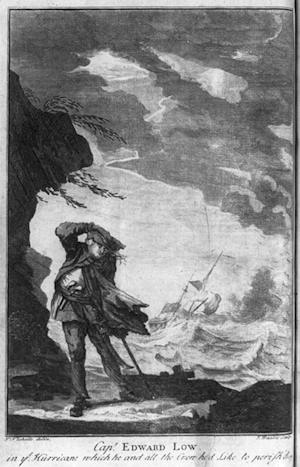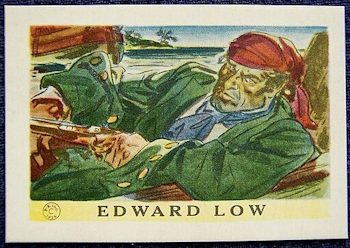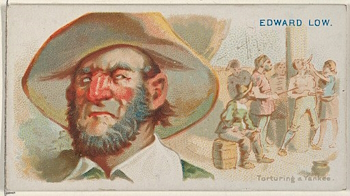 Presuming all the tales of his exploits are true, Edward Lowe, also Low or Loe, was probably the most cruel and bloodthirsty pirate of the Golden Age, possibly second only to François l’Olonnais. He is reported to have been prone to violence from an early age. The legend of his savagery spread far and wide. With a fearsome reputation and a small fleet of ships, Lowe and his crew captured at least a hundred ships during his short career, burning most of them.
Presuming all the tales of his exploits are true, Edward Lowe, also Low or Loe, was probably the most cruel and bloodthirsty pirate of the Golden Age, possibly second only to François l’Olonnais. He is reported to have been prone to violence from an early age. The legend of his savagery spread far and wide. With a fearsome reputation and a small fleet of ships, Lowe and his crew captured at least a hundred ships during his short career, burning most of them.
Early life
According to Charles Johnson’s A General History of the Pyrates, Edward Lowe was born in 1690 in Westminster, London. He was born into poverty and was active as a petty criminal like the rest of his family from an early age. His brother Richard was hanged for burglary in 1707 when Ned was only 17. He fled to Boston, Massachusetts in circa 1710 where he continued his life of crime. He married Eliza Marble in 1714 and had a son, who died not long after birth in 1719, he also had a daughter named Elizabeth. His wife’s death left him to raise his daughter alone. The loss of his wife had a profound effect on him, and he subsequently joined a sloop bound for Honduras loading and transporting logs, leaving his daughter behind.
Early pirating career
Lowe rebelled after being denied provisions, firing a musket at the captain, but narrowly missing him and killing another unfortunate crew member. Lowe and the other crew members were ejected from the sloop, but they soon seized a merchant vessel off Rhode Island becoming pirates in the process. They took several vessels off the north American coast before heading towards the Caribbean. There Lowe teamed up with the ruthless George Lowther of the sloop Happy Delivery acting as his first mate and together they sailed south, where they terrorized shipping around Grand Cayman. Lowe later took command of a captured 6-gun brigantine called the Rebecca with a crew of 44 men, shortly after which Lowe and Lowther parted ways on amicable terms.
Lowe the pirate captain
 In June 1722, Lowe raided Port Roseway, Nova Scotia successfully attacking 13 fishing and merchant vessels, offering no quarter if they resisted. He took the 10-gun, 80-ton schooner Fancy as his flagship, sinking the other vessels and abandoning the Rebecca. Lowe often made use of the tactic of flying false colours, which was an accepted tactic at the time, although a ship was supposed to raise its true colours on attacking. After an unsuccessful counter with a man-of-war Lowe had mistakenly believed to be a merchant vessel, he sailed to the Azores in the east Atlantic, where he captured a former French or Portuguese warship Rose Pink. He seized more vessels while in the Azores. George Roberts, a mate on the British ship King Sagamore captured by Lowe, claimed he took on the title of commodore at this point.
In June 1722, Lowe raided Port Roseway, Nova Scotia successfully attacking 13 fishing and merchant vessels, offering no quarter if they resisted. He took the 10-gun, 80-ton schooner Fancy as his flagship, sinking the other vessels and abandoning the Rebecca. Lowe often made use of the tactic of flying false colours, which was an accepted tactic at the time, although a ship was supposed to raise its true colours on attacking. After an unsuccessful counter with a man-of-war Lowe had mistakenly believed to be a merchant vessel, he sailed to the Azores in the east Atlantic, where he captured a former French or Portuguese warship Rose Pink. He seized more vessels while in the Azores. George Roberts, a mate on the British ship King Sagamore captured by Lowe, claimed he took on the title of commodore at this point.
After sailing to the Canaries and Cape Verde, he then sailed back to the coast of Brazil with the aim of plundering the rich shipping there, but bad weather forced him to return to the Caribbean. He lost the Rose Pink near Surinam when it capsized due to inexperience while being careened, leaving him with the schooner Squirrel and low water supplies. Lowe went on to capture many more sloops, including one that he kept for himself, naming it the Fortune. He tried to reach Tobago but unfavourable winds and strong currents prevented him from reaching there. Instead they arrived at the French island of Grenada, where through trickery they captured a sloop, which he made his own, renaming it the Ranger. His quartermaster Francis Spriggs, who had been with him since the beginning of his pirating career, took over the Squirrel, renaming it the Delight. Sprigg later stole away in the dead of night after a dispute with Lowe.
 At the beginning of 1723 Lowe and his men took even more sloops, taking one as his own vessel, calling it the Fortune. They also captured a Portuguese ship, Nostra Signiora de Victoria, in January 1723, mutilating and murdering the captain and the crew after the former threw a bag of gold coins overboard to prevent the pirates from getting their hands on it. A bounty was eventually put on Lowe’s head in the Caribbean, so he he joined forces Charles Harris and fled to the Azores. Coming under pressure in the Azores, he then sailed to the Carolinas, but suffered a significant defeat at the hands of HMS Greyhound commanded by Peter Solgard in June 1723. Lowe managed to escape in the Fancy with 150,000 pounds in gold, leaving Harris and the Ranger to their fate. Harris and 25 of the captured pirates were hanged. Lowe became increasingly crueller to his English victims after the encounter with HMS Greyhound.
At the beginning of 1723 Lowe and his men took even more sloops, taking one as his own vessel, calling it the Fortune. They also captured a Portuguese ship, Nostra Signiora de Victoria, in January 1723, mutilating and murdering the captain and the crew after the former threw a bag of gold coins overboard to prevent the pirates from getting their hands on it. A bounty was eventually put on Lowe’s head in the Caribbean, so he he joined forces Charles Harris and fled to the Azores. Coming under pressure in the Azores, he then sailed to the Carolinas, but suffered a significant defeat at the hands of HMS Greyhound commanded by Peter Solgard in June 1723. Lowe managed to escape in the Fancy with 150,000 pounds in gold, leaving Harris and the Ranger to their fate. Harris and 25 of the captured pirates were hanged. Lowe became increasingly crueller to his English victims after the encounter with HMS Greyhound.
After sailing north, Lowe attacked some whalers and fishing boats, treating the captives brutally, setting one crew adrift at sea, and even beheading the sailing master of another vessel. Even Lowe’s Crew found he was becoming increasingly cruel and refused to torture the crews of two fishing boats. Heading south in late June 1723 Lowe captured a French ship with 22 guns and a large Virginian merchant vessel named the Merry Christmas. He then rejoined forces with George Lowther and Francis Spriggs in July 1723. Both Spriggs and Lowther soon abandoned Lowe, leaving him with the Merry Christmas armed and 34 guns.
The cruel and brutal pirate
“Of all the piratical crews that were ever heard of, none of the English name came up to this, in barbarity. Their mirth and their anger had much the same effect, for both were usually gratified with the cries and groans of their prisoners; so that they almost as often murdered a man from the excess of good humour, as out of passion and resentment; and the unfortunate could never be assured of safety from them, for danger lurked in their very smiles.”
— Philip Ashton, forced on his time with Low’s crew, but escaped in May 1723
 The gruesome details of his various acts of torture, mutilation, and murder are well known and not necessary to describe in detail here as there are enough accounts available, but if you want to know more about his alleged acts of cruelty watch the video on Ned Lowe, One Of The Most Brutal Pirates To Ever Sail The Seven Seas: Edward “Ned” Low, on the History of Pirates YouTube channel. In Lowe’s case, surrendering without a fight was no guarantee of being spared the torture. Ironically, one failed torture session led to one of Low’s crew members accidentally cutting him in the mouth. Botched surgery left Lowe scarred. Although he could be extremely cruel, he refused to press married men into service lest their wives be left widowed, but also because they were more likely to desert, and he also released any captured women unharmed and unmolested, probably because he had also once himself been married. He clearly regretted both losing his wife and abandoning his daughter. It is generally accepted he was one of the most cruel and terrifying pirates of the Golden Age.
The gruesome details of his various acts of torture, mutilation, and murder are well known and not necessary to describe in detail here as there are enough accounts available, but if you want to know more about his alleged acts of cruelty watch the video on Ned Lowe, One Of The Most Brutal Pirates To Ever Sail The Seven Seas: Edward “Ned” Low, on the History of Pirates YouTube channel. In Lowe’s case, surrendering without a fight was no guarantee of being spared the torture. Ironically, one failed torture session led to one of Low’s crew members accidentally cutting him in the mouth. Botched surgery left Lowe scarred. Although he could be extremely cruel, he refused to press married men into service lest their wives be left widowed, but also because they were more likely to desert, and he also released any captured women unharmed and unmolested, probably because he had also once himself been married. He clearly regretted both losing his wife and abandoning his daughter. It is generally accepted he was one of the most cruel and terrifying pirates of the Golden Age.
Lowe’s unknown fate
Lowe’s end is uncertain. Charles Johnson in A General History of Pyrates claimed Lowe was last seen near the Canaries and Guinea. It is reported he was sailing for Brazil and was lost in a storm. It is even suggested he made it to Brazil and lived out his days there, or was killed by the indigenous Miskito. A claim by the author of the book The Pirates Own Book: Authentic Narratives of the Most Celebrated Sea Robbers (1837), Charles Ellms, is that his crew mutinied because of his cruelty and the murder of a shipmate, setting him adrift without provisions, or alternatively that they cut his throat in the night while he slept. The Merry Christmas was later sighted without Lowe and it was said he was picked up by a French ship while adrift, tried in Martinique, and hanged their in 1724. In March 1726 HMS Diamond reported seeing a periagua with 9 men on board, one believed to be Lowe, but were unable to pursue. In 1739 a man identified as Ned Lowe was seen fleeing a fort in Porto Bello, where he had allegedly served on a Spanish gun crew in the war of Jenkin’s Ear against the British. The National Maritime Museum in London states he was never caught and lived out his life in Brazil.
For more information on Ned Low watch the informative video below by Gold and Gunpowder.
